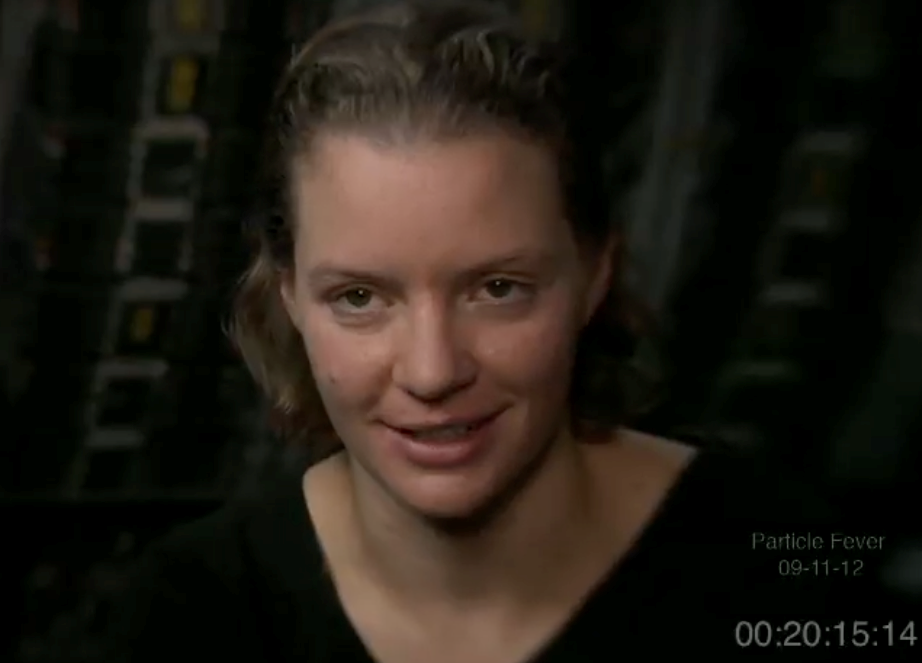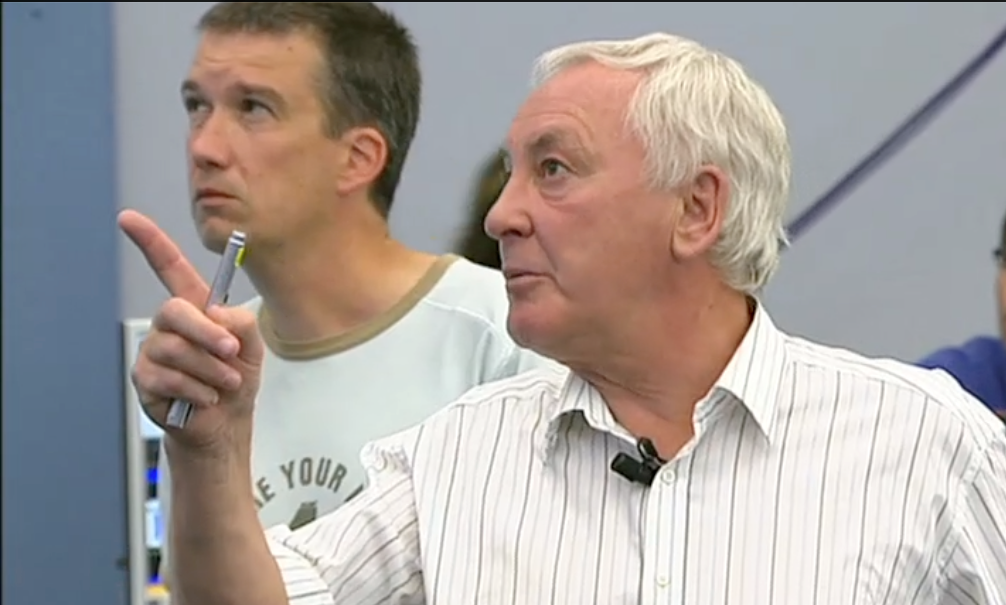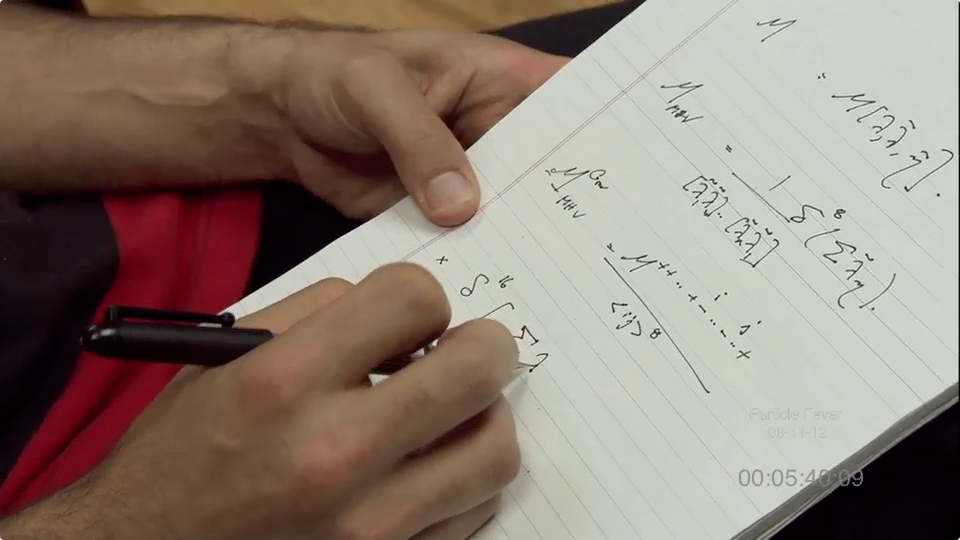Update: this movie, Particle Fever, ended up winning a ton of awards, being shown at a ton of film festivals including Telluride, being reviewed in a ton of surprised and delighted publications including the New York Times, and generally ending up exactly the way you’d want it to. This post ran October 18, 2012, before the movie came out.

As part of LWON’s unintended series on science and art, or maybe its focus on unexpected behavior in physicists, please meet David Kaplan. He’s a Johns Hopkins theorist whose specialty is creating the theories beyond the theory that almost accounts for all the matter and energy in the universe. As such, he was involved in Large Hadron Collider (the LHC) experiment that last summer found the Higgs boson. But he hadn’t known they’d find it, no one knew they’d find it. Theory had been predicting for 30 years they’d find it, but no data refuted or confirmed the theory; the large American collider to do the experiment had been cancelled, the LHC was being repeatedly delayed and was so expensive that they’d be given one shot and if no Higgs, then no more big colliders. Physicists were getting older, their careers were shrivelling, they weren’t sleeping, maybe the very question was dumb.
In the midst of all this, seven years ago, Kaplan was explaining the what-if-no-Higgs story to a friend with a PhD in poetry criticism. The friend was impressed: at no other time in the history of science was there a single point at which a whole field could potentially come to a screeching halt. It sounded like a white-knuckle movie. Kaplan thought so too, so he made one.
As it happens, Kaplan had begun his educational career in film school making silly little movies, had decided he wasn’t cut out for a filmmaker and, as one would, became a physicist instead. He thought a movie about the LHC search for the Higgs would be a good match for his interests and bought a nice camera. Next he asked Sheldon Glashow, a Nobel Prize-winning theorist, “What if nothing happens at the LHC?” and Glashow said, “Absolutely something will happen. This field is too much fun for this to be the end” — a great quote from a great man, but Kaplan in recording it screwed up the sound. He told his sister that he not only wasn’t doing physics, he couldn’t even do film. She introduced him to a producer/director who made a short, completely charming movie clip which begins with a physicist saying, “Thiss are two, thiss are two protons,” and for which Kaplan paid using his fellowship money. Then he tried to use the clip to raise more money, and couldn’t.
So he went back to the LHC for the summer, life went on, and he had to get tenure at Hopkins which he eventually did. Then out of the blue a director called, then two producers, and they agreed to raise money. Kaplan’s team found a list of all the “quants” on Wall Street, “quants” being young physicists who’d gone into finance, (and you wondered who thought up financial derivatives, didn’t you). Eventually enough people and enough foundations gave them money, and they hired a genius editor who not only actually wrote the book on editing but was also fascinated with physics.
Meanwhile, Kaplan and his collaborators had settled on seven people whom the movie would follow: three theorists (including Kaplan), three experimentalists (including Monica Dunford, whose picture is at the top of the post), and an instrumentalist (Mike Lamont, the urgently important and never recognized machine guy). And the crew had been filming. The crew knew lighting and angles, Kaplan knew what needed to go into the story.
For instance: in 2008 right after the experiment began, one of its fancy magnets blew out and the experiment stopped in its tracks for over a year. Kaplan knew they needed to film the moment the experiment turned back on, when tense physicists bunched up in a room looking at a square in which, oh joy!, a spot of light suddenly appeared: relief, relaxation, big smiles. Another instance: a delighted physicist walks around the room with her laptop, cradling it like a baby, holding it open and showing the screen to everyone: “Look at this beautiful plot. Have you seen this beautiful plot? Is there anyone I haven’t shown this beautiful plot to yet?”
Kaplan also knew the physics had to be soft-pedalled. “Physicists are in the truth business,” he says, “and they need to explain everything that’s going on.” But the movie’s audience wouldn’t need to understand the physics words or the labels on the axes of the laptop’s plot; they’d know to be happy when the spot of light appears, they’d want the physicists to succeed. Kaplan needed the audience to be inside, to be in the movie world in which the characters have a mission and the audience feels the urgency and fear and glory – understanding not so much the result of the mission, Kaplan says, but its reason, that is, where the mission begins. “There’s a purity to this,” he says. “This is what humans do.”
The movie is all but done. Its title is Particle Fever, it’ll probably be completely done (“picture lock”) in early 2013, it’s two hours long, it has cost $1.4 million, and now they need to find a distributor. Kaplan, though obsessed, hasn’t been excited by the filmmaking process. “It’s not like physics at all,” he says. Physics is clear and clean, you’re right or wrong, physicists tell you when they agree. Getting a film right is not only murkily magical and nobody quite tells you the truth, but sometimes people in the industry are fragile: “Physicists,” says Kaplan, “are not fragile.”
Meanwhile, they’re doing screenings, then tinkering, then doing more screenings and more tinkering, getting the tone right, evoking the truth of the experience. The movie has no script: “Oh no. No, no, no,” Kaplan says. ”The real world has to be treated as sacred.” With no script, the story is all in the editing. Part of the editor’s genius, he thinks, is mixing the music. In one scene, a brilliant theorist is writing on the board, Greek letters and numbers and relations; he’s writing fast, chalk stabbing at the board hard, equation after equation, bam, bam, bam. Then music comes in quietly underneath, a sharp little drumbeat, bam bam bam, and you get this idea that it’s the theorist thinking, neurons firing, one thought after another, bam bam bam. Then the scene cuts to the theorist’s feet, now propped up on his desk, his foot tapping bam bam, those equations going step after step all the way to his feet, he’s thinking with his whole body.
Kaplan treats the film as though it were a physics project and thinks about it all the time. “The film has taken an order one fraction of my time for five years,” he says. But he needs to get back to physics: “I worry about decoupling from my field and I won’t be able to get back. So I’ll take six months to rehab and learn what people have been doing.” He’s liked film editing, he says, “but I love calculating.”
_______
Stills from Particle Fever, courtesy of David Kaplan


As an amateur astro and reader of Physics Today, your story
was a fun read. Believe have seen Particle Fever on PBS.